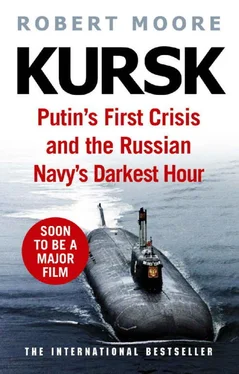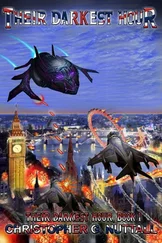The submarine herself was over 155 metres long, so she was resting at a depth far less than her own length. Had she done the impossible and ended up resting vertically, some 40 metres of the submarine would have reared above the surface. The escape hatch over the ninth compartment would have been several yards above the waves.
With compartments one to five flooded, both hulls punctured, and her twin 190-megawatt reactors shut down, the Kursk was fatally wounded. The crowning achievement of the legendary Rubin design bureau in St Petersburg and the Sevmash shipyard on the White Sea lay devastated on the bottom of the Barents Sea.
She had taken a decade to design, three years to build, and just 135 seconds to destroy.
For the survivors in the stern compartments of the crippled submarine the ordeal was just beginning. One hundred metres separated the point of the explosion and the sixth compartment just aft of the nuclear reactors. The engineers at the shipyard on the White Sea had spoken of the boat’s ‘survivability’, and in one sense they had been proved right. It seems inconceivable that any other submarine in the world would have afforded the chance of life to so many of her crew after twin explosions of this size. What occurred to the Kursk was the worst nightmare imaginable for the Sevmash shipyard and the Rubin design bureau, but it was also their most remarkable achievement.
The sixth compartment was manned by five sailors led by Captain-Lieutenant Rashid Ariapov, the young married officer from Uzbekistan whose wife had told him just a few weeks earlier that she was pregnant with their first child. He was in charge of the submarine’s propulsion systems. The seventh and eighth compartments housed the team in charge of the main engines and turbogenerators, a further sixteen men, led by Ariapov’s friend Dmitri Kolesnikov and Sergei Sadilenko, both men with the rank of captain-lieutenant. In the final compartment, the ninth, three more sailors served as mechanics.
Just before the torpedo launch, we know, two of the sailors in the stern had moved forward, and one crew member had come aft, leaving twenty-three men behind the protective wall of the reactors. They had heard the standard warning bell and listened to the command post notifying them of the imminent firing.
The sailors in the aft must have been thrown to the deck by the shock waves, and waited in horror as the submarine buckled and convulsed, alarms ringing out. The sound of tearing steel screeched through the ship. In all four aft compartments depth metres would have told them that the Kursk was rapidly plunging downwards. Communication links with the control room were severed, leaving the sailors in the aft isolated and terrified. They can only have guessed at the horrors that were being inflicted on their colleagues and friends farther forward. There was no way for them to know what had happened, but they must have deduced that either there had been a massive collision with a ship or submarine, or else one of their own torpedoes or missiles had detonated.
For the first few moments after the second explosion they were thrust into a world where survival was completely out of their own hands. Had the pressure hull ruptured over the stern, they would have faced instant death. The physics of the explosions and the work of designers in St Petersburg and engineers in an Arctic shipyard several years earlier were determining whether they would be alive in a few seconds’ time. They must have stared desperately at the bulk-heads and hatches, waiting to see if these protective barriers would withstand the shock waves and the crushing pressure of the outside ocean.
By the time the submarine had slammed into the seabed, carving a shallow channel in the silt, the Kursk had lost communications, heating, ventilation, and all but emergency lighting. The hydraulic and electrical systems had collapsed. The twenty-three sailors were entombed.
As they lay on the deck, or clutched at machinery to maintain their balance, the deafening echoes of the detonations faded away. Amid the baffling horror of what they were facing, they still had no comprehension of the ordeal that now lay ahead.
I: 11.28 a.m., SATURDAY, 12 AUGUST
On board Delta IV submarine the Karelia, north-east of Kildin Island
Thirty-two nautical miles from the Kursk , the Russian ballistic-missile submarine the Karelia glided through the water at periscope depth. At the age of thirty-six, her commanding officer, Captain Andrei Korablev, is one of the young stars of the Northern Fleet’s submarine flotilla. The Karelia is a giant Delta IV-class SSBN, one of the ‘boomers’ that the US Navy seeks to track at every available opportunity. On board at least a dozen missiles were sitting silently in their launch tubes, each with multiple warheads capable of destroying large swathes of the United States. In addition, several others had been converted for test firings.
Calm and methodical, Korablev’s self-belief and confidence would be regarded as arrogance in any other profession. His father was the captain of a Soviet diesel submarine, and he grew up on the Baltic base of Kronstadt with the sounds and smells of a naval port all around him. Joining the submarine fleet seemed the most natural step. He lives and breathes the Navy, relishes the responsibility of being on patrol with Russia’s nuclear-deterrent force, and enjoys the challenge of evading the American submarines with their superior technology. To outwit the Americans requires the oldest of Russian military skills: cunning, improvisation, stamina.
The Karelia ’s crew was working with consummate professionalism. Of all the boats in the Fleet, the Karelia has the reputation for being the most popular submarine, with the lowest turnover of sailors in the Russian Flotilla. Other crews began calling her ‘the President’s submarine’ after Vladimir Putin visited the Karelia for a brief training exercise a few months earlier. Enjoying their celebrity status, the sailors came up with their own motto: ‘If not us, then who?’
In less than an hour, Korablev would order a ballistic-missile test firing, set for 12.08 p.m.
The shock waves of the Kursk explosions rocked the Karelia , sending a shiver straight down her hull. Shouts of alarm resounded through the submarine, and even as he struggled to understand what had happened, Korablev ordered immediate damage reports from all of his compartment commanders. He assumed that the Karelia had struck an underwater object, or a depth charge had detonated close to the submarine. From the control room, demands for immediate information were shouted to the sonar operators. The two distinct shock waves had been felt a couple of minutes apart, the second far more powerful than the first. The compartment reports all came back negative: no leaks or other damage were detected.
Korablev wanted a second opinion, and he consulted Rear Admiral Shchegolev, a division commander who was aboard the Karelia to monitor the performance of the senior officers, a role known as ‘command riding’. Both men arrived at the same conclusion: the source of the shock waves must have been an underwater explosion linked to the exercise. With a total of thirty surface ships and four submarines reaching the final stage of the exercise, a weapons detonation or depth charge seemed the most likely explanation. During Korablev’s briefing at Northern Fleet Headquarters five days earlier, he had been told only about his specific tasks, and he was not privy to the orders for the other warships.
Korablev relaxed a little and decided that the Karelia ’s missile launch would go ahead as planned. The Fleet admirals would not thank him for radioing in an alarmist report, and Korablev certainly did not want to be blamed for unnecessary communication or for panicking over a weapons test that had nothing to do with him. After all, the Karelia was a nuclear-weapons platform, not a coastguard vessel. There would be no prizes for sending signals that could betray her location to American or British submarines almost certainly lurking nearby.
Читать дальше












